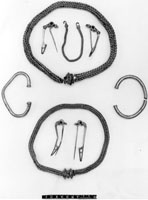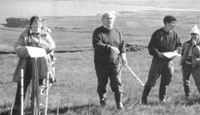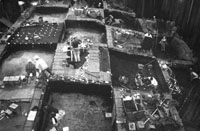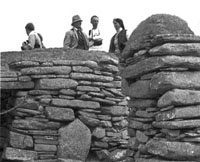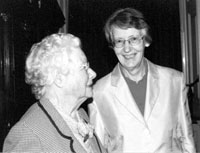|
|
|
|
The
Winchester Hoard
|
|
|||
|
This discovery
is also important because of the close co-operation that was possible
between the finder and archaeologists from Winchester Museum Service
and the British Museum. Hampshire is one of a small part of England
covered by the pilot of the Portable Antiquities Recording Scheme, a
Heritage Lottery Funded project to voluntarily record the finds made
by metal detectorists and other amateurs. Because of the work of Sally
Worrell, the PARS Recording Officer for Hampshire, strong relations
have been established between many local metal detectorists and the
archaeological establishment. The finder, Mr Halls, carefully recorded
the exact location of his finds after the initial discovery of the first
gold brooches. It was then possible for Tony Spence and JD Hill from
the British Museum, working with Winchester Museum Service, to organize
a detailed investigation of the find spot. This ongoing work suggests
that the gold objects were deposited in a prominent part of the landscape,
away from contemporary settlements, burials and shrines. This is the
first time archaeologists from the British Museum have investigated
the context of a Treasure find since the 1996 Treasure Act replaced
the old law of Treasure Trove. This case shows the value that investigating
the find spots of major metal detector finds has to provide vital information
about the nature and context of these finds. It also shows the importance
of the Portable Antiquities Recording Scheme, without which it is unlikely
that this level of investigation and co-operation with metal detectorists
could have taken place. J.D. Hill
|
|||
|
|
This
issue of PAST is dedicated to Sara Champion with affection and respect
from her colleagues in the Prehistoric Society. It will come as no surprise
to anyone who knew her to know that a concert, and a number one pop album
by the band Coldplay have all been dedicated to her so PAST 38 is in good
company. Sara had diverse interests and this issue has the usual range
of news and has also assembled something of the flavour of Sara's interests.
There is the review of the conference held in Ireland by the society,
contributions by women and about women, items from amateurs and professionals,
news on Iron Age finds of a gold hoard at Winchester and a very rich female
burial at Wetwang, plus European news. We also draw attention to the Society
website and mention some new websites so that members can enjoy the prehistoric
surf. Linda Hurcombe |
|
An important
new Iron Age burial has been discovered in the East Yorkshire village
of Wetwang. The new find is the grave of a mature lady buried was an
iron mirror and a two-wheeled horse drawn cart, chariot or carriage.
This burial is the 15th chariot or vehicle burial to have been discovered
in East Yorkshire, and belongs to the well-known local burial rite practiced
in East Yorkshire in the Middle Iron Age (c.400 to 100 BC). This is
the second chariot/cart burial to have been excavated in recent times
that contained the body of a woman. Four others have been male graves.
That this was a woman's grave has prompted some media speculation, and
certainly the study of her burial will need a careful reassessment of
the little studied area of gender in the British Iron Age.
|
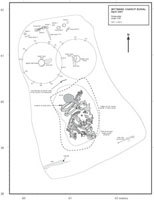 Preliminary plan of the excavated grave showing the position of the body and surviving parts of the vehicle. Drawn by Stephen Crummy. Reproduced with the permission of the Trustees of the British Museum |
|
J.D. Hill
|
|
|
CORAL,
AMBER AND COCKLE SHELLS: TRADE IN THE MIDDLE LA TÈNE PERIOD. |
|
The trade between
the Mediterranean countries and those of temperate Europe during the
Iron Age has been a favourite topic of research for over a century
now. In more recent times it has been recognised that this was not
a case of steady development, but that during the middle phases of
the La Tène Iron Age, there had been some major recession,
which saw a drop in both the quantity and quality of the goods being
traded, notably in the period after about 400 BC. But also it was
accepted that the nature of this trade varied from period to period,
in terms of the objects traded, the routes and destinations, who was
participating and organising the trade, and who were the recipients.
One ot the high points, during Hallstatt D (the 6th century BC) saw
prestige 'diplomatic gifts' such as the Vix crater, followed by a
period in the 5th century of more prosaic bronze goods which were
reaching a wider class of individuals. The 4th and early 3rd centuries
saw a drop in this trade, a period which, using the watery analogies
so beloved of prehistorians, I characterised in 1984 as 'The Tide
Ebbs', a period when exotic goods virtually disappeared in temperate
Europe. Gradually trade picked up again, and by the 2nd century it
had achieved massive proportions, with tens of thousands of wine amphorae
from Italy reaching central France, accompanied by fine tablewares
and metal vessels. John Collis References
|
|
Four relatively intact incisors from the Hardinxveld sites were examined,
together with five fragmentary finds. The cutting end of an incisor from
Hardinxveld de Bruin had been trimmed to produce a chisel edge of about
half the original width. The other three incisors, from Hardinxveld Polderweg,
appear to have been trimmed to produce a knife-like blade rather than
a chisel end. All were damaged, apparently with none of the original cutting
edge left. While I was puzzling as to why anyone would remove all of a
ready-made chisel edge from an incisor, and what use it might be put to
without it, I turned to examine the fragments, all of which came from
Hardinxveld Polderweg. Two finds at least looked like the broken remains
of fairly complete worked incisors, but one was a very finely worked,
nicely rounded tip of an incisor about 20mm long and 3mm wide, with the
outer enamel remaining on one surface. The proximal end was broken, not
cut, and it was soon clear that it had broken off one of the relatively
intact incisors from the same site: the two finds had been made in successive
years and in different excavation squares, although only about 1 m apart.
The fact that both were recovered and could subsequently be brought back
together is a tribute to the skills of the excavators. |
 Figure 2. The two pieces of beaver incisor brought together to indicate the form of the original artefact. The incisor has been sliced longitudinally from mid point to tip, and the tip has been further worked to a flat rounded point. The object was originally about 12 cm long. |
|
When the two
pieces are put together (Figure 2), the result is a gently curved lower
incisor trimmed to a long, narrow slightly curving tip with a rounded
end, an object which from the precision of its manufacture looks as
if it was deliberately, confidently produced to a known template. Bryony Coles and Leendert Louwe Kooijmans References
|
|
|
|
It
is with regret that we report the death in March 2001 of Dr R.M. Baguley.
John Cruse writes that older members will remember Rodney Baguley as
a regular participant in the Society's study tours in the late 70s/early
80s. His visiting card listed his interests as 'polar research' and
'exploration' and his qualifications as B.A., Ph.D. and D.Litt. As a
tall man with long legs, Rodney was a very visible member of a tour
party. From feedback given by other members, it is apparent that some
of his colourful tales should probably have been taken with 'a pinch
of salt'.
|
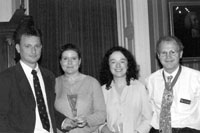 Mark White and Danielle Shreve, and Joanna Brück, after receiving their respective Baguley glasses from the new president of the Society, Prof. Graeme Barker |
|
|
|
REVIEW |
|
|
Sara took a keen interest in promoting women in archaeology and their achievements. At 94, Lady Aileen Fox must be one of the oldest Honorary Members of the Prehistoric Society and has lived through great changes in archaeology and society. She still occasionally attends research seminars at Exeter and last year published her latest book, reviewed here. By writing her
autobiography Lady Aileen Fox, has constructed a fascinating read not
just for those who like to glimpse the lives of others, but also created
a resource for those studying a history of the 20th century and women's
lives. For archaeologists, she has left a written account of the development
of the subject before and after the war, and developments in the teaching
of archaeology. The book works on all these different levels at once.
I am now on my second read and still finding new insights in the text.
Linda Hurcombe
|
| THE
SOCIETY AND THE WEB |
|||||||||||||
| We had always
wanted to establish a web site for the Society but the time had never
been quite right or we couldn't find an appropriate server, etc and nothing
had ever got done. So, when Sara Champion backed our idea and suggested
we use the Britarch server this seemed like the ideal opportunity. Luckily, one of us (Andrew) had the necessary know how and armed with Sara's article ('Archaeology on the World Wide Web: A user's field-guide'. Antiquity 71, 1027-1038, Dec 1997) we set about putting the Society on line. A primary aim was to attract new members from the student section of the archaeological community and to broaden our presence in areas of the world where membership leaflets might not reach. Immediately we saw results: enquiries came in thick and fast and in the first year we received at least 25% of our new members from the web site. With the new membership form to complement the web site, the numbers of new members per year has risen from 89 in 1996 to 207 in 2000. So far, the numbers for 2001 appear comparable to 2000. The experiment has clearly worked. The membership base has also widened to include members from Korea, Japan and the West Indies amongst others. Particularly reassuring was the realisation that many of the new members were students, ensuring the vibrancy of the Society in the 21st century. |
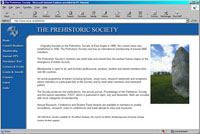 The Prehistoric Society Web Site |
||||||||||||
|
However, we became
increasingly aware that it was difficult to update the site instantly.
Immediate access to the site would allow us to put up 'hot press' items
and other up-to-the-minute news items. UCL kindly allowed us web space
and in February 2001 a newly-designed site, in keeping with the new
membership leaflet design of 2000, was put up at UCL (www.ucl.ac.uk/prehistoric).
This site contains everything you may wish to know about the Society
with details of lectures, events, grants, membership, Council Members,
the full text of PAST and abstracts of PPS online. Downloadable membership
and grant application forms are also available, thus cutting down on
administration costs. Web links gleaned from Sara's paper and from her
Champion's Choice column in PAST are also included.
Tessa Machling and Andrew Garner
|
|||||||||||||
| LATEST
NEWS FROM SILBURY HILL |
|
Various groups in
Britain felt that there was not sufficient information about the collapse
within Silbury or about mitigation. There was also concern regarding
the level of available funding for the project. Led by members of The
Ancient Sacred Landscapes Network (ASLaN) a peaceful protest was organised
for May 19th. The original wish had been to surround the base of the
Hill with people linking hands but Foot and Mouth restrictions, not
to mention the depth of the water around the mound, ruled this out. Gill Swanton
|
| FEASTING
ON MARMITE: NEOLITHIC SETTLEMENT IN IRELAND AND WESTERN BRITAIN, 20-22
APRIL 2001 In the midst of the first major outbreak of foot and mouth disease since 1967, the Prehistoric Society held their first conference in Belfast since, eh, 1967. As this conference demonstrated, most of the issues that are now 'hot suspects' for the Neolithic, were barely showing symptoms back then… |
|
In late April 2001,
almost 200 people attended a conference held by the Prehistoric Society
in the School of Archaeology and Palaeoecology, Queen's University Belfast,
organised by Ian Armit, Eileen Murphy, Eimear Nelis and Derek Simpson.
The title of the conference might have been 'Neolithic Settlement in
Ireland and Western Britain', but it was attended by archaeologists
from as far afield as France, the Netherlands, Canada and the US.
|
| WORLD
HERITAGE SITES |
||||
|
Historic Scotland
published its finalised Management Plan for the Heart of Neolithic Orkney
World Heritage Site in March 2001. Copies of this are available on CD
(£6.50 each). The Nomination Document has also been reprinted
(£10). Please send your order, adding 50p per item for p&p,
to Catherine Mackenzie, Retail, Historic Scotland, Longmore House, Salisbury
Place, Edinburgh, EH9 1SH.
|
|
PAST is happy to publicise conferences on this page. Please send details to the editor following the format below. If you want to use a PAST mailing to send out flyers please contact the editor for a quote. Mosens Guder - Facing Wood 2001, Silkeborg, Denmark: 30.10.01-31.10.01 Prehistoric Bedrock Quarries of the Central Appalachians: 9.11.01-11.11.01
Celtic Coinage 2001, Oxford: 6.12.01-7.12.01
TAG 2001 (Theoretical Archaeology Group): 13.12.01-15.12.01
Ninth International Conference on Hunting and Gathering Societies
(CHAGS 9). Edinburgh, Scotland: 9.02-13.9.02.
|
|||||||||||||||||
| SOCIETY
BITS AND PIECES... Our administrator Tessa Machling reports on various society business. |
|
Direct Debit & Gift Aid The Prehistoric Society needs a Treasurer
|
| |
The Prehistoric Society Home Page |
